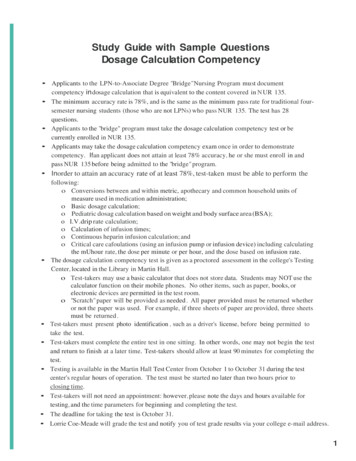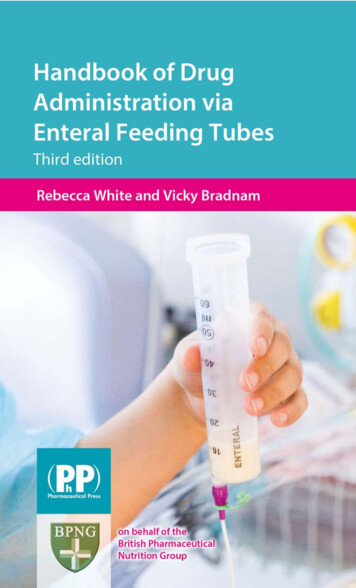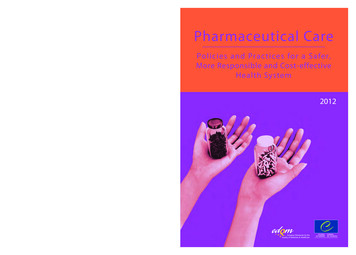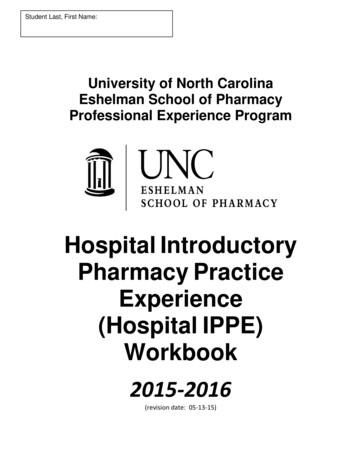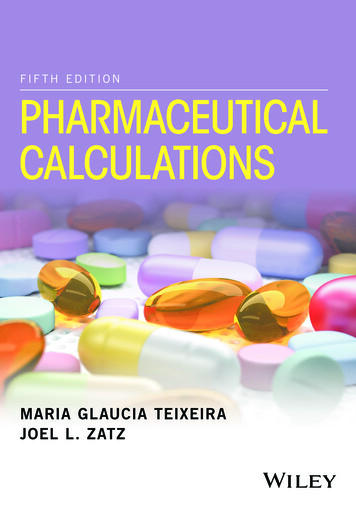
Transcription
FIF TH EDITIONPHARMACEUTICALCALCULATIONSMARIA GLAUCIA TEIXEIRAJOEL L. ZATZ
PHARMACEUTICALCALCULATIONS
FIFTH EDITIONPHARMACEUTICALCALCULATIONSMARIA GLAUCIA TEIXEIRAJOEL L. ZATZ
Copyright 2017 by John Wiley & Sons, Inc. All rights reserved.Published by John Wiley & Sons, Inc., Hoboken, New Jersey.Published simultaneously in Canada.No part of this publication may be reproduced, stored in a retrieval system, or transmitted in any form or by any means,electronic, mechanical, photocopying, recording, scanning, or otherwise, except as permitted under Section 107 or 108 ofthe 1976 United States Copyright Act, without either the prior written permission of the Publisher, or authorization throughpayment of the appropriate per-copy fee to the Copyright Clearance Center, Inc., 222 Rosewood Drive, Danvers, MA01923, (978) 750-8400, fax (978) 750-4470, or on the web at www.copyright.com. Requests to the Publisher for permissionshould be addressed to the Permissions Department, John Wiley & Sons, Inc., 111 River Street, Hoboken, NJ 07030, (201)748-6011, fax (201) 748-6008, or online at http://www.wiley.com/go/permission.Limit of Liability/Disclaimer of Warranty: While the publisher and author have used their best efforts in preparing thisbook, they make no representations or warranties with respect to the accuracy or completeness of the contents of this bookand specifically disclaim any implied warranties of merchantability or fitness for a particular purpose. No warranty may becreated or extended by sales representatives or written sales materials. The advice and strategies contained herein may notbe suitable for your situation. You should consult with a professional where appropriate. Neither the publisher nor authorshall be liable for any loss of profit or any other commercial damages, including but not limited to special, incidental,consequential, or other damages.For general information on our other products and services or for technical support, please contact our Customer CareDepartment within the United States at (800) 762-2974, outside the United States at (317) 572-3993 or fax (317) 572-4002.Wiley also publishes its books in a variety of electronic formats. Some content that appears in print may not be available inelectronic formats. For more information about Wiley products, visit our web site at www.wiley.com.Library of Congress Cataloging-in-Publication Data:Names: Teixeira, Maria Glaucia, author. Zatz, Joel L., 1935- author.Title: Pharmaceutical calculations / Maria Glaucia Teixeira, Joel L. Zatz.Description: Fifth edition. Hoboken, New Jersey : John Wiley & Sons, Inc.,[2017] Joel L. Zatz’s name appears first on the previous four editions. Includes bibliographical references and index.Identifiers: LCCN 2016036796 (print) LCCN 2016037823 (ebook) ISBN 9781118978511 (pbk.) ISBN 9781118978528 (pdf) ISBN 9781118978535 (epub)Subjects: MESH: Drug Dosage Calculations Drug Compounding–methods Pharmaceutical Preparations–administration & dosage Mathematics Dosage Forms Programmed InstructionClassification: LCC RS57 (print) LCC RS57 (ebook) NLM QV 18.2 DDC615.1/401513–dc23LC record available at https://lccn.loc.gov/2016036796Printed in the United States of America.10 9 87 6 5 43 2 1
To Alfred (Al), my life’s partner and soulmate,for his infinite friendship andgenuine contributions to this work.To my mother, Julia, the strongest womanI have ever known, for her example of tenacityand wise choices in life.Maria Glaucia Teixeira
TABLE OF CONTENTSXIIIPREFACECHAPTER 1CHAPTER 2CHAPTER 3REVIEW OF BASIC MATHEMATICAL PRINCIPLES11.1. Significant Figures1.2. Rounding Off1.3. Fractions1.4. Exponents and Powers1.5. Estimation1.6. Units1.7. Ratio1.8. Proportion1.9. Dimensional AnalysisPractice Problems2458101215151821SYSTEMS OF MEASUREMENT312.1. Metrology2.2. The Metric System2.3. The English Systems2.3.1. The Avoirdupois System2.3.2. The Apothecary or Troy System2.4. Measurement of Weight2.4.1. Metric Weight2.4.2. English Weight2.4.2.1. Avoirdupois Weight2.4.2.2. Apothecary Weight2.4.3. Practical Weight Equivalents2.5. Measurement of Volume2.5.1. Metric Volume2.5.2. English Volume2.5.3. Practical Volume Equivalents2.6. Measurement of Length2.7. Intersystem Relationships2.8. Household Equivalents and Metric EstimationPractice Problems31PRESCRIPTIONS AND MEDICATION ORDERS543.1.3.2.3.3.3.4.3.5.Prescribing AuthorityComponentsPractices To Prevent Medication ErrorsCommon AbbreviationsOutpatient Prescription Drug Orders3.5.1. Prescriptions for Manufactured Drug Products3.5.2. Prescriptions for Compounded Drug 60696969vii
viiiTABLE OF CONTENTS3.5.2.1.Types of Compounded Orders3.5.2.2.1. Formulation Based on Total Quantity3.5.2.3.2. Formulation Based on Single Dosage Unit3.6. Inpatient Medication Orders3.7. Interpretation3.8. Calculations To Check “DEA” Numbers3.9. Reducing and Enlarging Formulas3.10. Parts FormulasPractice ProblemsCHAPTER 4CHAPTER 5707071727777808790WEIGHING AND MEASURING IN PHARMACY PRACTICE1034.1. Measurement Errors4.2. Indication of Error4.2.1. Absolute Error: Indication of Error Based on MaximumDeviation and Significant Figures4.2.2. Relative Error: Indication of Error Based on Percentage ofEstimated Value4.3. Tolerance In Prescription Compounding and PharmaceuticalManufacturing4.4. Weighing and Measuring4.4.1. Electronic Balances4.4.2. Prescription Balances: Class A, Torsion4.4.2.1. Sensitivity Requirement (SR)4.4.2.2. Minimum Weighable Quantity (MWQ) orLeast Weighable Quantity (LWQ)4.4.2.3. Percent Error4.4.3. Volumetric Devices for Pharmaceutical Measurements4.4.3.1. The Meniscus and Effect of Viscosity4.4.3.2. Graduates4.4.3.3. Pipets (Pipettes)4.4.3.4. Syringes4.4.3.5. Droppers4.5. Aliquot Method and Triturations4.5.1. Solid–Solid Aliquot Method4.5.2. Solid–Solid Triturations4.5.3. Liquid–Liquid Aliquots and Triturations4.5.4. Solid–Liquid Aliquots4.5.5. Serial Dilutions4.6. Density4.7. Specific GravityPractice Problems103DOSAGE CALCULATIONS1605.1. Calculations Involving Dose, Size, Number of Doses,Amount Dispensed, and Quanity of a Specific Ingredient in a Dose5.2. Dosage Measured By Drops5.3. Dosage Based on Body Weight5.4. Dosage Based on Body Surface Area (BSA)5.5. Pediatric and Geriatric Dose Calculations5.6. Chemotherapy Dose CalculationsPractice 4187
TABLE OF CONTENTSCHAPTER 6CHAPTER 7CHAPTER 8ixDRUG CONCENTRATION EXPRESSIONS2036.1. Concentration6.2. Percentage Strength Expressions6.2.1. Percent Volume-in-Volume6.2.2. Percent Weight-in-Weight6.2.3. Percent Weight-in-Volume6.2.4. Default Rules for Percentage Expressions6.2.5. Prescriptions and Formulations with Ingredients Listed asPercentage6.2.6. Using Specific Gravity to Calculate the Exact Amount ofSolvent in a Solution6.2.7. Converting % w/w into %w/v Using Specific Gravity6.3. Stock Solutions, Concentrates, and Triturations6.4. Saturated Solutions6.5. Ratio Strength Expressions6.5.1. Ratio Volume-in-Volume6.5.2. Ratio Weight-in-Volume6.5.3. Ratio Weight-in-Weight6.6. Other Pharmaceutical Expressions of Drug Concentration6.6.1. Milligrams Per Milliliter (mg/mL)6.6.2. Milligrams Percent (mg%) and Miligrams Per Deciliter (mg/dL)6.6.3. Parts Per Million (ppm) and Parts Per Billion (ppb)6.6.4. Millimols, Milliequivalents, and Milliosmols Per Unit of VolumePractice Problems204DILUTION AND CONCENTRATION2577.1. Problem-Solving Methodologies7.1.1. Concentration Principle7.1.2. Mass Balance Equation7.1.2.1. Dilution of Powders or Solid Mixtures7.1.2.2. Mixing Different Strengths7.1.2.3. Modifying the Drug Concentration of aPrepared Product: Increasing Drug Concentration7.1.3. The CQ Equation: Concentration X Quantity7.1.3.1. Expanded CQ Equation7.1.4. Algebraic Calculations Using the Concentration Equationand the CQ Equation7.1.5. Alligation Alternate7.1.5.1. Use of Alligation When Combining MoreThan Two Products7.2. So, Which Method Should I Use?7.2.1. Stock Solutions Diluted by the PatientPractice Problems258ISOTONICITY3108.1. Principles8.2. Sodium Chloride Equivalent Values8.3. Isotonicity by the Sodium Chloride Equivalent Method8.3.1. Sodium Chloride Equivalent: Method 18.3.2. Sodium Chloride Equivalent: Method 28.4. Other Tonicity 91293296312315315318319
xTABLE OF CONTENTSCHAPTER 9CHAPTER 108.5. Isotonicity When One Ingredient is Already Isotonic8.6. Isotonic Buffered Solutions8.6.1. Using the White–Vincent Method to Adjust Tonicity8.7. Other Methods8.8. Determination of the Tonicity of a Solution (Hypotonic, Isotonic,or Hypertonic)Practice Problems321DOSAGE CALCULATIONS OF ELECTROLYTES3409.1. Molarity and Molality9.1.1. Mols and Millimols9.1.2. mmol/mL, mmol/L9.2. Electrolyte Dissociation, Valence, Equivalent, and Equivalent Weight9.3. Milliequivalents, mEq/mL, mEq/L9.3.1. Problem-Solving Methods for Milliequivalents9.4. Osmolarity (Osmolar Strength)9.4.1. Milliosmoles and mOsm/LPractice Problems341CALCULATIONS FOR INJECTABLE MEDICATIONSAND STERILE FLUIDS10.1. Reconstitution of Dry Powders10.1.1. Reconstituting with Volumes Other Than Those onManufacturer’s Label10.1.2. Considering Powder Volume10.1.3. Powders as Compounding Sources of Drugs10.2. Calculations Related to Units/ml (Insulin, Heparin) and OtherUnits of Potency10.2.1. Calculations of Insulin Single Dose and Combinations10.2.2. Calculations of Heparin Doses10.3. Intravenous Admixtures10.4. Extemporaneous IV Fluids10.5. Flow Rates in Intravenous SetsPractice ProblemsCHAPTER 11ENTERAL AND PARENTERAL NUTRITION11.1. Screening and Assessment of Nutritional Needs11.1.1. Body Mass Index (BMI), Waist Circumference, and AssociatedDisease Risks11.1.2. Assessment of Malnutrition11.2. Enteral Nutrition11.3. Parenteral Nutrition (PN): 2-in-1 and 3-in-1 Formulations11.4. Calculation of Nutritional Requirements11.4.1. Caloric Requirement Equations11.4.2. Fluid Requirement11.4.3. Protein Requirement (Nitrogen)11.4.4. Carbohydrate and Fat Requirements11.4.5. Micronutrient Requirements (Electrolytes, Vitamins,and Trace Elements)11.5. Calculations for Compounding Parenteral 18420420425425428428429
TABLE OF CONTENTS11.5.1. Calculation of Electrolytes11.5.2. Calculation of Carbohydrate and Fat11.5.3. Calculation of Protein11.5.4. Calculation of Other Additives11.6. Calculations Related to the Design of a PNPractice ProblemsCHAPTER 12MISCELLANEOUS PRACTICAL CALCULATIONS INCONTEMPORARY COMPOUNDING12.1. Compounding with Manufactured Dosage Forms12.1.1. Nonsterile Products12.1.2. Sterile Products12.2. Suppository Calculations12.2.1. Calibration of Molds12.3. Determination of Amount of Base/powder Occupied bythe Drug(s): Solid Dosage Forms12.3.1. Density Factor Method12.3.2. Quantity/Volume of Base Occupied by Drug (or DensityRatio Method)12.3.3. Dosage Replacement Factor Method12.4. Lozenges and Lollipops12.4.1. Lozenge/Lollipop Mold Calibration12.5. Selecting a Capsule Size12.5.1. The Rule of Sixes12.5.2. The Rule of Seven12.5.3. Volume Occupied by Active Ingredient in a Capsule12.6. Primary Emulsion Calculations (4:2:1 Ratio)12.7. A Little Touch of Veterinary CompoundingPractice PENDIX 1Systems of Measurement500APPENDIX 2Chemical Elements and Atomic Weights502APPENDIX 3Calibration of Medicinal Dropper503APPENDIX 4Solutions Used to Compound PN504APPENDIX 5Conversions: Temperature, Time, Proof Strength507APPENDIX 6HLB System511APPENDIX 7Drug as a Base Versus Salt or Ester514APPENDIX 8pH, Buffers, and Buffer Capacity517APPENDIX 9Normal Concentration525APPENDIX 10Biologics for Immunization527LITERATURE CONSULTED529INDEX531
PREFACETO THE STUDENTA goal of this new edition of Pharmaceutical Calculations is to update the material tocurrent changes in pharmacy practice, continuing with an active learning approach. It drawsupon previous experiences in the classroom, especially those over the 11 years since theprevious edition, working with pharmacy students with diverse backgrounds ranging frompre-pharmacy college to master degrees in scientific fields. The active learning approachmeans that the student is required to solve problems themselves and think about what theyare doing, rather than just demonstrating solution techniques. To glance ahead at thesolutions and answers to the problems defeats the process. Too often, students come in tosay that they understand and follow the solutions when the instructor does problems in class,but don’t know where to start when presented problems with the book closed. We think, as astudent, you will understand and follow the solutions provided as they involve simple logicand mathematical processes that you’ve learned since high school or earlier. The key toactive learning is putting in the time, doing the work, and thinking about what you are doing.Treat the practice questions at the end of each chapter as your quality control check or just totest your learned skills. And always do all the problems before glancing at the answers.Almost every topic contains some problems to test your understanding. Read theinformation in the topic and work on the question(s) in the space provided. We have found ithelpful to use an index card or a folded sheet of paper to cover everything below the linewhere the solutions and answers are provided. When you’re done, check your answer. If youare correct, move on to the next topic. If not, try the problem again before consulting thesolution. You may uncover your error and be able to do it right the second time. If you stillcan’t get it, you may need to go back to a few topics to see if there is something you missed.If all else fails, look at the solution. You may also want to consult the solution if youstruggled to get the right answer and wondered if a more direct approach is available.We assume that you can perform the usual arithmetic operations of addition, subtrac tion, multiplication, and division and that you can solve simple algebraic and exponentialequations. A quick review of certain techniques and practice questions are provided in Chapter1 of this edition in case you have gotten rusty and need to brush up. You will find out that thereare multiple ways to solve pharmaceutical calculations – there is no one “correct” way. Withpractice, you will find the approach that makes the most sense to you.Some topics will be easy for you and you’ll zoom through the text. Difficult spots willtake more time; in any case, stick with it and take as much time as you need to work throughthe material until you understand it and can handle the problems. Happy problem solving!NEW IN THIS EDITIONNew practice problems (NAPLEX-patterned) have been added, reflecting real-practicesituations a pharmacist and/or other health care professionals will encounter when workingat various settings. These new problems also prepare the pharmacist for NAPLEX exams byxiii
xivPREFACEstimulating critical thinking and encouraging logical reasoning and attention to detailedinformation, sometimes available in a real-world situation (or provided in a question) but notneeded for the mathematical solution of a problem.New features of this edition also include the following: The main focus across the 12 chapters is on reflecting traditional teaching of pharma ceutical calculations applicable to daily pharmacy practice activities and required forsuccessful licensing. Chapters provided in logical sequence such that each builds knowledge upon previouslylearned topics. New format providing numbered sections and subsections that relate to each chapter,facilitating retrieval of topics. Updated content to every chapter. New chapter dedicated to practical calculations used in contemporary compounding. New appendices. Solutions and answers for all problems.OTHER FEATURES IN THIS EDITIONSince its first edition, it has been the main goal of this textbook to provide a level consistentwith the requirements of students being presented to the applications of basic mathematicaltechniques to the pharmaceutical/health fields, often part of the early professional curricu lum. We have thus retained some and added other important introductory topics anddescriptions that are frequently needed while students are introduced to pharmaceuticaldosage forms, drug delivery systems, and learning basic compounding skills. These topicsare not strictly needed to solve pharmaceutical calculation problems, but are includednonetheless because experience has shown that students often need this background.Some features retained and enhanced from the fourth edition are as follows: Chapter objectives informing the students what they will master upon successfulcompletion of each chapter. Introduction of topics in a programmed manner, allowing self-study. Various practice problems that were designed to offer opportunities for creative thoughtand application of the content of each section. Appendices providing basic information and useful references.Maria Glaucia TeixeiraUniversity of Wyoming, Laramie, WY
CHAPTER1REVIEW OF BASIC MATHEMATICALPRINCIPLESLEARNING OBJECTIVESable to:1.2.3.4.5.After completing this chapter the student should beRecall the skills of basic mathematical operations required to work in the health eld.Use estimation as a means of preventing errors.Perform mathematical operations containing units.Compare two quantities (ratio).Apply ratio, proportion, and dimensional analysis in problem solving.Pharmacists, nurses, doctors, and most health-related professionals perform basic calcula tions as a daily practice. While working in a variety of settings, pharmacists, for example,need to calculate doses and determine the number of dosage units required to fillprescriptions accurately, must determine the quantities of pharmaceutical ingredientsrequired to compound formulas, and perform calculations related to dose adjustmentsfor disease state management, and so on. The correct drug, strength, and amount of eachmedication prescribed that is dispensed in pharmacies must be finally checked by thepharmacist, who is legally accountable for an incorrect dose or dispensing of a wrong drug.The fact that most pharmaceuticals are prefabricated and not prepared inside the pharmacydoes not lessen the pharmacist’s responsibility.Modern drugs are effective, potent, and therefore potentially toxic if not takencorrectly. An overdose may be fatal. Knowing “how to” calculate the amount of eachdrug and “how to” combine them is not sufficient. Of course, dispensing a subpotent dose isnot satisfactory either. The drug(s) given will probably not elicit the desired therapeuticeffect and will therefore be of no benefit to the patient. Clearly, the only satisfactoryapproach is one that is completely free of error. Absolute accuracy is any health profes sional’s goal. Since our goal when performing calculations is the correct answer, it is logicalto suppose that any rational approach to a problem that results in the correct answer isacceptable. While this is true, some approaches are more coherent and practical than others.In this text we strive to use a method that requires as few steps as possible and that withwhich you will feel comfortable. Usually, the simplest, most direct pathway to the solutionallows less opportunity for error in computation than does one that is more complicated.In this chapter, we will review some techniques basic to all types of calculations. Tohelp you regain the basic mathematical operations required to work in the health field, wewill briefly review significant figures, rounding off, fractions, exponents, power-of-10notation, and estimation, and will make sure that you can solve simple algebraicPharmaceutical Calculations, Fifth Edition. Maria Glaucia Teixeira and Joel L. Zatz. 2017 by John Wiley & Sons, Inc. Published 2017 by John Wiley & Sons, Inc.1
2CHAPTER 1REVIEW OF BASIC MATHEMATICAL PRINCIPLESexpressions. We will go over how units participate in arithmetic operations and how we cantake advantage of units in our calculations. Finally, we will review dimensional analysis,ratio, and proportion.You will probably find that you are already familiar with all or most of thesetechniques. After this refreshing, you will make rapid progress through the self-study formatof this text. If you need further review or instruction, that will be provided.1.1. SIGNIFICANT FIGURESSignificant figures are digits that have practical consequences in pharmacy. Sometimes, in acalculated dose at a clinical setting, or in a weighed or measured amount at a compoundingpharmacy, zeros are significant; other times they just designate the order of magnitude of theother digits indicating the location of the decimal point. Since the majority of medicationscurrently prescribed are manufactured products, significant figures have minor significance tothe counter pharmacist, if no compounding is involved on a daily basis. For the compoundingpharmacist, however, all weighing and measuring will have a degree of accuracy that is onlyapproximate, due to the many sources of error related to the type and limitations of theinstrument used, room temperature, personal skills, attentiveness, and so on.While compounding pharmacists must achieve the highest accuracy possible with theirequipment, one could never claim to have weighed 5 mg of a solid substance on a torsionbalance with sensitivity of 10 mg, or that 33.45 mL of a liquid was measured in a 50 mLgraduate with only 1 mL graduations. Consequently, when writing quantities, the numbersshould contain only the digits that are significant within the precision of the instrument.However, when performing calculations, all digits should be retained until the end. The finalresult will then be rounded so that the accuracy is implied by the number of significant figures.The following illustrate the practical meaning of significant figures:(a) If 0.0125 g is weighed, the zeros are not significant and only indicate the location of thedecimal point.(b) For a measured weight of 1250.0 g, the last zero may or may not be significant,depending on the method of measurement. The zero will not be significant if indicatingthe decimal point; alternatively, it may indicate that the weight is closer to 1249 or1251 g, in which case the zero is significant.(c) For some recorded measurements, the last significant figure is “approximate,” while allpreceding figures are “accurate.” For example, in a measured volume of 398.0 mL, alldigits are significant but it is accurate to the nearest 0.1 mL, which means themeasurement falls between 397.5 and 398.5, or that the measurement was madewithin 0.05 mL. In 39.86 mL, the 6 is approximate, with the true volume beingbetween 39.855 and 39.865 mL. This means that 39.8 mL is accurate to the nearest0.01 mL, or that the measurement was made within 0.005 mL.(d) It is thus possible to calculate the maximum error incurred in every measurement. Usingthe examples above, we would have0:05 mL 100% 0:013%398:00:005 mL 100% 0:013%39:86
SIGNIFICANT FIGURES3(e) When establishing the number of significant figures in mathematical operations, use thefollowing practical rules: The result of addition and subtraction should contain the same number of decimalplaces as the component with the fewest decimal places. For example,12.5 g 10.65 g 8.30 g 31.45 g 31.5 g. The result of products and quotients should have no more significant figures than thecomponent with the smallest number of significant figures. For example, 2.466 mg/dose 15 doses 36.99 37 mg.Now practice with the following:(a) What is the maximum percentage error experienced in the measurement of 248.0 mL?12.60 g?(b) Determine the number of significant figures.Amounts weighedNumber of significant figuresi. 4.58 gii. 4.580iii. 0.0458iv. 0.0046(c) Which of the following has the greatest degree of accuracy (solve as in 3.5 mL 0.05mL, accurate to the nearest 0.1 mL)?15.7 mL 15.70 mL 15.700 mL (d) Using significant figure practical rules, calculate the following:5.5 g 12.35 g 4.40 g 2.533 mg/day 5 days -- -- -- -- -- -- -- -- -- -- -- -- -- -- -- -Answers(a) 0.02%; 0.04%(b) (i) 3, (ii) 4, (iii) 3, (iv) 2 significant figures(c) 15.700 mL has the greatest degree of accuracy(d) 22.3 g; 12.7 or 13 mg
4CHAPTER 1REVIEW OF BASIC MATHEMATICAL PRINCIPLESSOLUTIONS(a) The zero in 248.0 mL is a significant figure, implying that the measurement was madewithin the limits 247.95 and 248.05 mL. The possible error is then calculated as0:05 mL 100% 0:02%248:0Applying the same reasoning for 12.60 g, the maximum error is0:0397% 0:04%0:005 mL 100% 12:60(b) 3, 4, 3, 2 significant figures, respectively.(c) 15.7 mL 15.7 mL 0.05 mL, accurate to the nearest 0.1mL.15.70 mL 15.70 mL 0.005 mL, accurate to the nearest 0.01 mL.15.700 mL 15.700 mL 0.0005 mL, accurate to the nearest 0.001 mL. (The lastmeasurement has the greatest degree of accuracy.)(d) 5.5 g 12.35 g 4.40 g 22.25 g 22.3 g2.533 mg/day 5 days 12.665 12.7 mg 13 mg1.2. ROUNDING OFFThe number of decimal places to which a medical calculation can be precisely calculated isdetermined by the number of significant figures. As mentioned earlier, when performingcalculations, all figures should be retained until the end, when rounding off is performed.Rounding off is based on the last decimal place. If it is 5, the preceding decimal place isrounded up to the next digit, for example, 2.356 2.36. If it is 5, the preceding decimalplace is left as it is, for example, 2.33 2.3.Practice rounding off with the following measurements:(a) 2.344 g (b) 1.5 2.1114 mg (c) 5.246 mL (using a pipette calibrated 1/10 mL) (d) How many powder charts (individual doses) would a compounding pharmacist be ableto prepare from a 10.5 g mixture of powders, if each chart should contain 1.33 g?-- -- -- -- -- -- -- -- -- -- -- -- -- ----- -Answers(a) 2.34 g(b) 3.2 mg(c) 5.3 mL(d) 7.9 charts 7 powder charts (doses must be accurate) and 0.9 g wasteSOLUTIONS(a) In 2.344 the last decimal place is 5, so it is rounded to 2.34 g.
FRACTIONS5(b) 1.5 2.1114 mg 3.167 3.2 mg, with only one decimal point because 1.5 is the leastprecise number in the operation (limiting number of significant digits) and it has onlyone place after the decimal.(c) In 5.246 the last decimal place is 5, so it would be rounded to 5.25. However, themeasuring tool is calibrated in 1/10 mL, which means only fractions as large as 0.1 of amilliliter can be measured accurately so 5.3 mL should be measured.(d) 10:5 g chart 1:33 g 7:8947 7:9 charts (10.5 is the least precise number in theoperation). Since each dose must be complete, there is enough powder mixture todispense only seven charts with accurate doses and 0.9 g will be discarded as waste.1.3. FRACTIONSMost math skills required in health care fields require handling fractions, which measure a portionor part of a whole number and are usually written as common fractions or decimal fractions.A common fraction, frequently referred simply as a fraction, can be exemplified as 1/513or , 3/16 or , and so on. The first or upper number, the numerator, identifies the number516of parts with which we are concerned, while the second or lower number, the denominator,indicates the number of aliquot parts into which the numerator is divided. When thenumerator is divided by the denominator, the result is called the quotient.When trying to perform pharmaceutical calculations with common fractions, you willfind some principles and rules very handy:(a) If the denominator of a fraction is 1, the value corresponds to the number in the3numerator, for example, 3.1(b) If the value in the numerator of a fraction is lower than the one in the denominator, then thevalue of the fraction is 1. If the numerator and denominator are the same, the value of thefraction is 1. Numerator with greater value than the denominator will generate values 1.333 1; 1Examples: 1;532(c) If both the numerator and denominator are multiplied or divided by the same number, thevalue of a fraction does not change. By the other hand, the value will increase if a numberis multiplied by the numerator and will decrease if multiplied by the denominator. Theopposite occurs if either the nominator or the denominator is divided independently.Examples:3 2 6 0:754 2 83 4 12 3 444as 3 0:75333 4 4 16 4as 0:188 0:75(d) Practical consequences of the principles described above, which will reduce computingerrors, are as follows:(i) The ability to reduce fractions to the lowest common denominator, or the smallestnumber divisible by all denominators in consideration.
6CHAPTER 1REVIEW OF BASIC MATHEMATICAL PRINCIPLES(ii) The possibility to reduce a fraction to lower terms when recording a final result orduring a series of calculations.1 3 2Ex.1. Reducing , , to a common denomination:5 4 3By serial testing it can be found that 60 is the smallest number divisible by 5, 4, and3, then91 1 12 12 5 5 12 60 3 3 15 45; all have the same denominator 4 4 15 60 2 2 20 40 ; 3 3 20 60Ex.2. Reducing12to the lowest term:4801212 121 480 480 12 40A decimal fraction is a fraction with a denominator of 10 or any other power of 10.Usually, the numerator and the decimal point are satisfactory to express a decimal125 0:1 and 0:025.fraction, for example,101000Consequences of this definition include the following:(a) Moving the decimal point one place to the right multiplies a number by 10, two placesby 100, and so on. Similarly, moving the decimal point one place to the left divides thenumber by 10 and so on.Examples: 0.1 10 10.025 100 0.00025(b) A decimal fraction may be changed to a common fraction, and if desire
CHAPTER 5 DOSAGE CALCULATIONS 160 5.1. Calculations Involving Dose, Size, Number of Doses, Amount Dispensed, and Quanity of a Specific Ingredient in a Dose 161 5.2. Dosage Measured By Drops 169 5.3. Dosage Based on Body Weight 171 5.4. Dosage Based on Body Surface Area (BSA) 174 5



